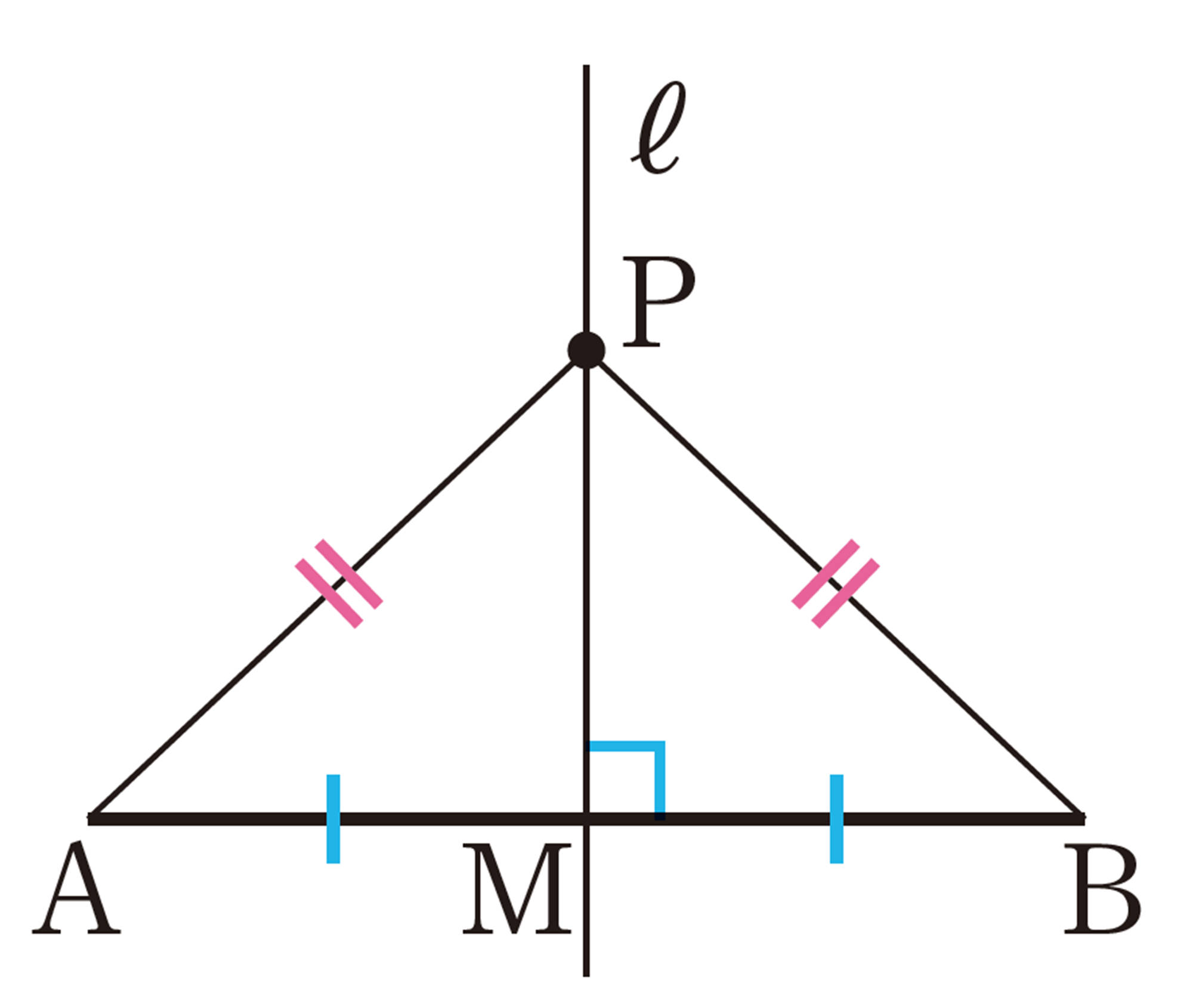<2年p.250>
応用
1
⑴ [mathjax]\(\angle x=105^{\circ}\)
⑵ [mathjax]\(\angle x=68^{\circ}\)
⑶ [mathjax]\(\angle x=90^{\circ}\)
2
[mathjax]\(\angle x=56^{\circ}\)
❷ [mathjax]\(PA=PB\)であることをいうためには,PAとPBが対応する辺になる[mathjax]\(\triangle PAM\)と[mathjax]\(\triangle PBM\)が合同であることを証明すればよい。
❸(証明)
[mathjax]\(\triangle PAM\)と[mathjax]\(\triangle PBM\)において,
仮定から,
共通な辺だから,[mathjax]\(PM=PM\quad\cdots\cdots\text{③}\)
①,②,③より,2組の辺とその間の角がそれぞれ等しいから,
[mathjax]\(\hspace{58pt}\triangle PAM \equiv \triangle PBM\)
合同な図形の対応する辺は等しいから,
[mathjax]\(\hspace{78pt}PA=PB\)
4
[mathjax]\(\triangle AED\)と[mathjax]\(\triangle FEC\)において,
仮定から,[mathjax]\(\hspace{36pt}DE=CE\hspace{24pt}\cdots\cdots\text{①}\)
平行線の錯角は等しいから,
[mathjax]\(AD/\!/CF\)より,[mathjax]\(\angle ADE=\angle FCE\quad\cdots\cdots\text{②}\)
対頂角は等しいから,
[mathjax]\(\hspace{64pt}\angle AED=\angle FEC\quad\cdots\cdots\text{③}\)
①,②,③より,1組の辺とその両端の角がそれぞれ等しいから,
[mathjax]\(\hspace{62pt}\triangle AED \equiv \triangle FEC\)
合同な図形の対応する辺は等しいから,
[mathjax]\(\hspace{80pt}AE=FE\)
活用
1
⑴ [mathjax]\(\triangle ACB\)と[mathjax]\(\triangle DCE\)において,
仮定から,
対頂角は等しいから,
[mathjax]\(\hspace{12pt}\angle ACB=\angle DCE\quad\cdots\cdots\text{③}\)
①,②,③より,1 組の辺とその両端の角がそれぞれ等しいから,
[mathjax]\(\hspace{10pt}\triangle ACB\equiv \triangle DCE\)
合同な図形の対応する辺は等しいから,
[mathjax]\(\hspace{28pt}AB=DE\)
⑵ ㋑
星形n角形 P.145〜146
① 略
② [mathjax]\(360^{\circ}\)
③ [mathjax]\(540^{\circ}\)
④ 表の左から,[mathjax] \(360,540,720,900,1080\)
⑤ 略
⑥ 略
5章 三角形・四角形 [解答]
トライ P.156
略
5章のまとめの問題 P.175〜177
1
⑴ 頂角
⑵ 1つの鋭角,他の1辺
⑶ 中点
⑷ 4つの角が等しい四角形
2
⑴ [mathjax]\(72^{\circ}\)
⑵ 二等辺三角形
(理由)[mathjax]\(\angle BCD=\angle BDC=72^{\circ}\)であるから。
3
⑴ [mathjax]\(\triangle ABE\)と[mathjax]\(\triangle CDF\)において,
仮定から,[mathjax]\(\angle AEB =\angle CFD=90^{\circ}\quad\cdots\cdots\text{①}\)
平行線の錯角は等しいから,
[mathjax]\(AB/\!/DC\) より,
[mathjax]\(\hspace{40pt}\angle ABE=\angle CDF\hspace{40pt}\cdots\cdots\text{②}\)
平行四辺形の対辺は等しいから,
[mathjax]\(\hspace{56pt}AB=CD\hspace{53pt}\cdots\cdots\text{③}\)
①,②,③より,直角三角形の斜辺と1つの鋭角がそれぞれ等しいから,
[mathjax]\(\hspace{40pt}\triangle ABE\equiv\triangle CDF\)
⑵ CF,錯角,FC,1組の対辺が平行で等しい
4
二等辺三角形
(証明)[mathjax]\(\triangle BMD\)と[mathjax]\(\triangle CME\)において,
仮定から,
MD,MEはそれぞれ辺AB,ACの垂線であるから,
[mathjax]\(\hspace{32pt}\angle MDB=\angle MEC=90^{\circ}\quad\cdots\cdots\text{③}\)
①,②,③より,直角三角形の斜辺と他の1辺がそれぞれ等しいから,
[mathjax]\(\hspace{28pt}\triangle BMD\equiv \triangle CME\)
したがって,[mathjax]\(\angle B=\angle C\)
2つの角が等しいから,[mathjax]\(\triangle ABC\)は二等辺三角形である。
応用
1
長方形,正方形

